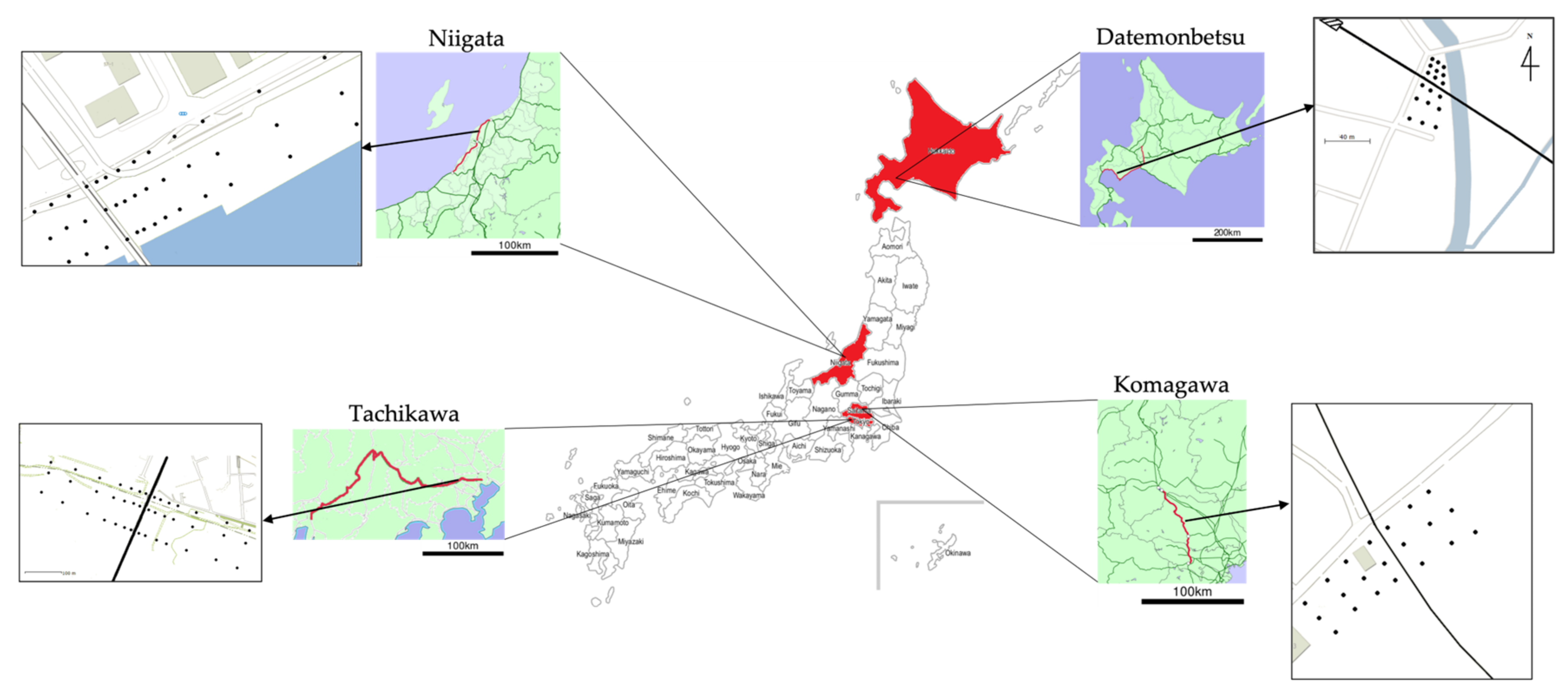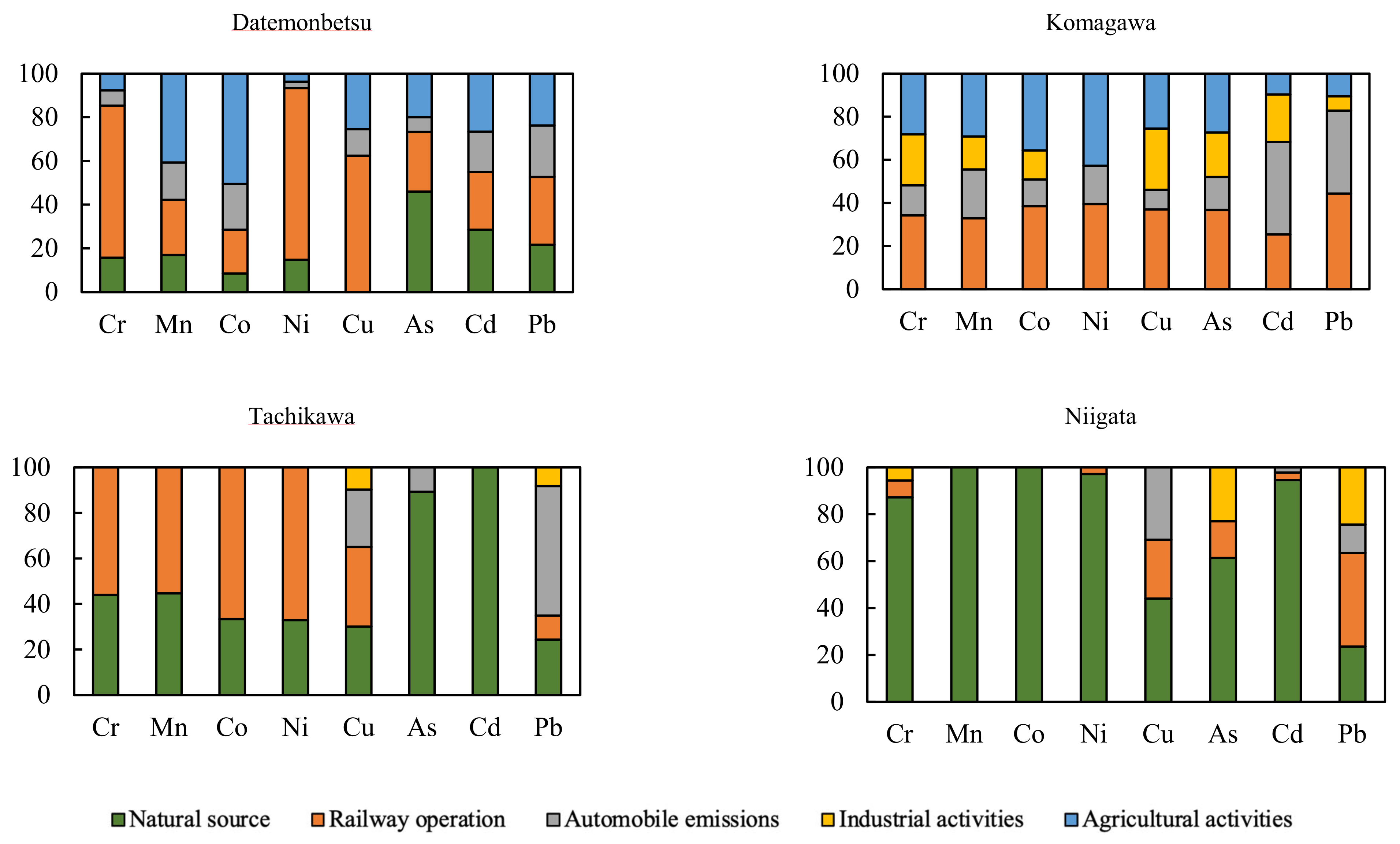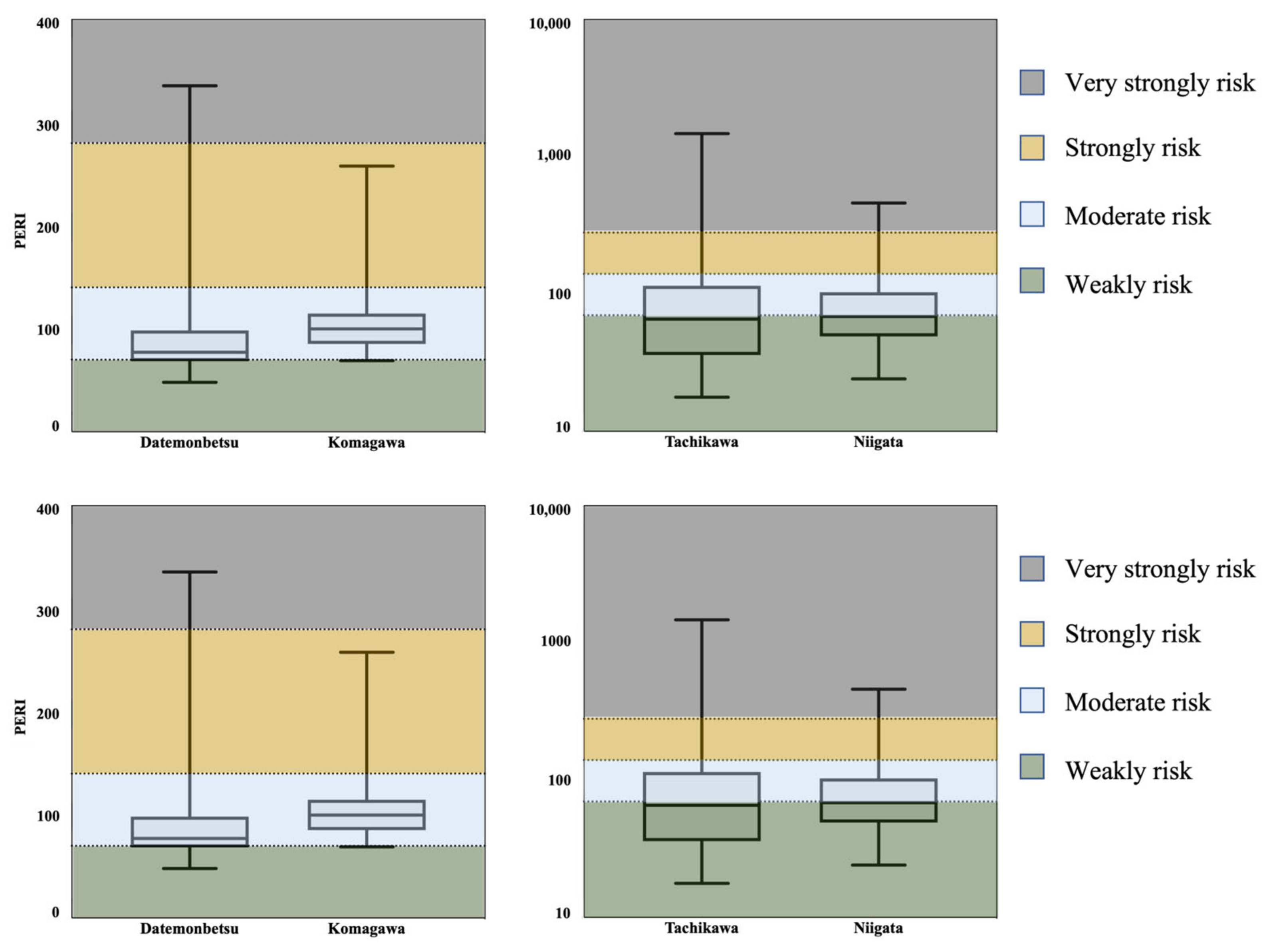Source Apportionment and Risk Assessment of Soil Heavy Metals due to Railroad Activity Using a Positive Matrix Factorization Approach
Abstract
:1. Introduction
2. Materials and Methods
2.1. Study Area and Railway Information
2.2. Sampling and Analysis
2.3. PMF Model
2.4. Environmental Risk Assessment
2.4.1. Geoaccumulation Index (Igeo)
2.4.2. Potential Ecological Risk Index (PERI)
2.4.3. PMF-ERA
2.5. Health Risk Assessment
2.5.1. Noncancer and Cancer Risks
2.5.2. PMF-HHRA
3. Results and Discussions
3.1. Contamination Characteristics
3.1.1. Descriptive Statistics of Heavy Metals
3.1.2. Difference Analysis
3.2. Source Apportionment by PMF
3.2.1. Results of the Positive Matrix Factorization Model
3.2.2. Source Contributions
3.3. Environmental Risk Assessment by PMF-ERA
3.3.1. Concentration-Oriented Environmental Risk Assessment
3.3.2. Source-Oriented Environmental Risk Assessment
3.4. Human Health Risk Assessment by PMF-HHRA
3.4.1. Concentration-Oriented Health Risk Assessment
3.4.2. Source-Oriented Health Risk Assessment
4. Conclusions
Supplementary Materials
Author Contributions
Funding
Institutional Review Board Statement
Informed Consent Statement
Data Availability Statement
Conflicts of Interest
References
- Rajmohan, N.; Prathapar, S.A.; Jayaprakash, M.; Nagarajan, R. Vertical distribution of heavy metals in soil profile in a seasonally waterlogging agriculture field in Eastern Ganges Basin. Environ. Monit. Assess. 2014, 186, 5411–5427. [Google Scholar] [CrossRef] [PubMed]
- Kabata, P.A.; Mukherjee, A.B. Trace Elements from Soil to Human; Springer: Berlin/Heidelberg, Germany, 2007; pp. 381–399. [Google Scholar]
- Wiłkomirski, B.; Sudnik-Wójcikowska, B.; Galera, H.; Wierzbicka, M.; Malawska, M. Railway transportation as a serious source of organic and inorganic pollution. Water Air Soil Pollut. 2011, 218, 333–345. [Google Scholar] [CrossRef] [PubMed] [Green Version]
- Koch, M.; Rotard, W. On the contribution of background sources to the heavy metal content of municipal sewage sludge. Water Sci. Technol. 2001, 43, 67–74. [Google Scholar] [CrossRef] [PubMed]
- Cheng, S. Effects of Heavy metals on plants and resistance mechanisms. Environ. Sci. Pollut. Res. 2003, 10, 256–264. [Google Scholar] [CrossRef] [PubMed]
- Chaudhari, P.R.; Gupta, R.; Gajghate, D.G.; Wate, S.R. Heavy metal pollution of ambient air in Nagpur City. Environ. Monit. Assess. 2012, 184, 2487–2496. [Google Scholar] [CrossRef]
- Alengebawy, A.; Abdelkhalek, S.T.; Qureshi, S.R.; Wang, M. Heavy Metals and Pesticides Toxicity in Agricultural Soil and Plants: Ecological Risks and Human Health Implications. Toxics 2021, 9, 42. [Google Scholar] [CrossRef]
- Karuppiah, M.; Gupta, G. Impact of Point and Nonpoint Source Pollution on Pore Waters of Two Chesapeake Bay Tributaries. Ecotoxicol. Environ. Saf. 1996, 35, 81–85. [Google Scholar] [CrossRef]
- Velea, T.; Gherghe, L.; Predica, V.; Krebs, P.R. Heavy metal contamination in the vicinity of an industrial area near Bucharest. Environ. Sci. Pollut. Res. 2009, 16 (Suppl. S1), 27–32. [Google Scholar] [CrossRef]
- Dwivedi, A.K.; Vankar, P.S. Source identification study of heavy metal contamination in the industrial hub of Unnao, India. Environ. Monit. Assess. 2014, 186, 3531–3539. [Google Scholar] [CrossRef]
- Jewett, S.C.; Naidu, A.S. Assessment of Heavy Metals in Red King Crabs Following Offshore Placer Gold Mining. Mar. Pollut. Bull. 2000, 40, 478–490. [Google Scholar] [CrossRef]
- Kim, J.Y.; Kim, K.W.; Ahn, J.S.; Ko, I.; Lee, C.H. Investigation and risk assessment modeling of As and other heavy metals contamination around five abandoned metal mines in Korea. Environ. Geochem. Health 2005, 27, 193–203. [Google Scholar] [CrossRef] [PubMed]
- Angelovičová, M.; Kunová, S.; Čapla, J.; Zajac, P.; Bučko, O.; Angelovič, M. Comparison of fatty acid profile in the chicken meat after feeding with narasin, nicarbazin and salinomycin sodium and phyto-additive substances. J. Environ. Sci. Health Part B 2016, 51, 374–382. [Google Scholar] [CrossRef] [PubMed]
- Nouri, H.; Beecham, S.; Kazemi, F.; Hassanli, A.M. A review of ET measurement techniques for estimating the water requirements of urban landscape vegetation. Urban Water J. 2013, 10, 247–259. [Google Scholar] [CrossRef]
- Waeles, M.; Tanguy, V.; Ricardo, D.; Riso, R.D. On the control of copper colloidal distribution by humic substances in the Penzé estuary. Chemosphere 2015, 119, 1176–1184. [Google Scholar] [CrossRef]
- Baltrenas, P.; Vaitiekunas, P.; Baciulyte, Z. Investigation of soil’s contamination with heavy metal by railway transport. J. Environ. Eng. Landsc. 2009, 17, 244–251. [Google Scholar] [CrossRef]
- Zhang, H.; Wang, Z.; Zhang, Y.; Hu, Z. The effects of the Qinghai–Tibet railway on heavy metals enrichment in soils. Sci. Total Environ. 2012, 439, 240–248. [Google Scholar] [CrossRef]
- Ma, J.H.; Chu, C.J.; Li, J.; Song, B. Heavy Metal Pollution in Soils on Railroad Side of Zhengzhou-Putian Section of Longxi-Haizhou Railroad, China. Pedosphere 2009, 19, 121–128. [Google Scholar] [CrossRef]
- Liu, Y.H.; Ren, X. Solidification, repair and long-term stability analysis of heavy metal contaminated soil on Zhongchuan railway. Fresenius Environ. Bull. 2021, 30, 2193–2200. [Google Scholar]
- Vaiškūnaitė, R.; Jasiūnienė, V. The analysis of heavy metal pollutants emitted by railway transport. Transport 2020, 35, 213–223. [Google Scholar] [CrossRef]
- Srishti, J.; Sharma, S.K.; Vijayan, N.; Mandal, T.K. Seasonal characteristics of aerosols (PM2.5and PM10) and their source apportionment using PMF: A four year study over Delhi, India. Environ. Pollut. 2020, 262, 114337. [Google Scholar] [CrossRef]
- Mohammad, H.G.; Assefa, M.M.; Lakshmi, R. Water quality assessment and apportionment of pollution sources using APCS-MLR and PMF receptor modeling techniques in three major rivers of South Florida. Sci. Total Environ. 2016, 566–567, 1552–1567. [Google Scholar] [CrossRef]
- Schaefer, K.; Einax, J.W. Source apportionment and geostatistics: An outstanding combination for describing metals distribution in soil. Clean–Soil Air Water 2016, 44, 877–884. [Google Scholar] [CrossRef]
- Liu, J.; Liu, Y.J.; Liu, Y.; Liu, Z.; Zhang, A.N. Quantitative contributions of the major sources of heavy metals in soils to ecosystem and human health risks: A case study of Yulin, China. Ecotoxicol. Environ. Saf. 2018, 164, 261–269. [Google Scholar] [CrossRef] [PubMed]
- Adgate, J.L.; Willis, R.D.; Buckley, T.J.; Chow, J.C.; Watson, J.G.; Rhoads, G.G.; Lioy, P.J. Chemical mass balance source apportionment of lead in house dust. Environ. Sci. Technol. 1998, 32, 108–114. [Google Scholar] [CrossRef]
- Wang, Z.; Watanabe, I.; Ozaki, H.; Zhang, J. Enrichment and bioavailability of trace elements in soil in vicinity of railways in Japan. Arch. Environ. Contam. Toxicol. 2018, 74, 16–31. [Google Scholar] [CrossRef]
- Paatero, P.; Tapper, U. Positive matrix factorization: A non-negative factor model with optimal utilization of error estimates of data values. Environmetrics 1994, 5, 111–126. [Google Scholar] [CrossRef]
- U.S.EPA. EPA Positive Matrix Factorization (PMF) 5.0 Fundamentals and User Guide; Office of Emergency and Remedial Response: Washington, DC, USA, 2014. [Google Scholar]
- Mullar, G. Index of geoaccumulation in sediments of the Rhine River. Geojournal 1969, 2, 108. [Google Scholar]
- Takeda, A.; Kimura, K.; Yamasaki, S. Analysis of 57 elements in Japanese soils, with special reference to soil group and agricultural use. Geoderma 2004, 119, 349–354. [Google Scholar] [CrossRef]
- Hakason, L. An ecological risk index for aquatic pollution control: A sedimentological approach. Water Res. 1980, 14, 975–1000. [Google Scholar] [CrossRef]
- Xu, Z.Q.; Ni, S.J.; Tuo, X.G.; Zhang, C.J. Calculation of Heavy Metals’ Toxicity Coefficient in the Evaluation of Potential Ecological Risk Index. Environ. Sci. Technol. 2008, 2, 112–115. (In Chinese) [Google Scholar]
- Fernandez, J.A.; Carballeria, A. Evaluation of contamination, by different elements, in terrestrial mosses. Arch. Environ. Contam. Toxicol. 2001, 40, 461–468. [Google Scholar] [CrossRef] [PubMed]
- Wu, J.; Li, J.; Teng, Y.; Chen, H.; Wang, Y. A partition computing-based positive matrix factorization (PC-PMF) approach for the source apportionment of agricultural soil heavy metal contents and associated health risks. J. Hazard Mater. 2020, 388, 121766. [Google Scholar] [CrossRef] [PubMed]
- USEPA. Risk Assessment Guidance for Superfund, Vol I: Human Health Manual Evaluation; Office of Emergency and Remedial Response: Washington, DC, USA, 1989. [Google Scholar]
- Cao, S.; Duan, X.; Zhao, X.; Ma, J.; Dong, T.; Huang, N.; Wei, F. Health risks from the exposure of children to As, Se, Pb and other heavy metals near the largest coking plant in China. Sci. Total Environ. 2014, 472, 1001–1009. [Google Scholar] [CrossRef] [PubMed]
- Chen, H.; Teng, Y.; Lu, S.; Wang, Y.; Wu, J.; Wang, J. Source apportionment and health risk assessment of trace metals in surface soils of Beijing metropolitan, China. Chemosphere 2016, 144, 1002–1011. [Google Scholar] [CrossRef]
- Mamut, A.; Eziz, M.; Mohammad, A.; Ismayil, D. Assessment of trace element pollution of farmland soils in the oases along the lower reaches of the Kaidu River and its potential health risks. J. Agro-Environ. Sci. 2018, 37, 2142–2149. (In Chinese) [Google Scholar]
- Shen, Z.; Xu, D.; Li, L.; Wang, J.; Shi, X. Ecological and health risks of heavy metal on farmland soils of mining areas around Tongling City, Anhui, China. Environ. Sci. Pollut. Res. 2019, 26, 15698–15709. [Google Scholar] [CrossRef]
- Staszewski, T.; Malawska, M.; Studnik-Wόjcikowska, B.; Galera, H.; Wiłkomirski, B. Soil and plants contamination with selected heavy metals in the area of a railway junction. Arch. Environ. Prot. 2015, 41, 35–42. [Google Scholar] [CrossRef] [Green Version]
- Stojic, N.; Pucarevic, M.; Stpjic, G. Railway transportation as a source of soil pollution. Transp. Res. Part D Transp. Environ. 2017, 57, 124–129. [Google Scholar] [CrossRef]
- Li, D.; Liao, Y. Spatial Characteristics of Heavy Metals in Street Dust of Coal Railway Transportation Hubs: A Case Study in Yuanping, China. Int. J. Environ. Res. Public Health 2018, 15, 2662. [Google Scholar] [CrossRef] [Green Version]
- Meng, X.; Ai, Y.; Li, R.; Zhang, W. Effects of heavy metal pollution on enzyme activities in railway cut slope soils. Environ. Monit. Assess. 2018, 190, 197. [Google Scholar] [CrossRef]
- Samarska, A.; Kovrov, O.; Zelenko, Y. Investigation of Heavy Metal Sources on Railways: Ballast Layer and Herbicides. J. Ecol. Eng. 2020, 21, 32–46. [Google Scholar] [CrossRef]
- Eludoyin, O.S.; Ogbe, O.M. Assessment of Heavy Metal Concentrations in Pawpaw (Carica papaya Linn.) around Automobile Workshops in Port Harcourt Metropolis, Rivers State, Nigeria. J. Health Pollut. 2017, 7, 48–61. [Google Scholar] [CrossRef] [Green Version]
- Appiah-Adjei, E.K.; Baidu, E.E.; Adjei, K.A.; Nkansah, M.A. Potential heavy metal pollution of soils from artisanal automobile workshops: The case of Suame Magazine, Ghana. Environ. Earth Sci. 2019, 78, 62. [Google Scholar] [CrossRef]
- Agyemang, J.; Gyimah, E.; Ofori, P.; Nimako, C.; Akoto, O. Pollution and Health Risk Implications of Heavy Metals in the Surface Soil of Asafo Auto-Mechanic Workshop in Kumasi, Ghana. Chem. Afr. 2022, 5, 189–199. [Google Scholar] [CrossRef]
- Li, Y.; Dong, Z.; Feng, D.; Zhang, X.; Jia, Z.; Fan, Q.; Liu, K. Study on the risk of soil heavy metal pollution in typical developed cities in eastern China. Sci. Rep. 2022, 12, 3855. [Google Scholar] [CrossRef] [PubMed]
- Yin, G.; Zhu, H.; Chen, Z.; Su, C.; He, Z.; Chen, X.; Qiu, J.; Wang, T. Spatial Distribution and Source Apportionment of Soil Heavy Metals in Pearl River Delta, China. Sustainability 2021, 13, 9651. [Google Scholar] [CrossRef]
- Wang, S.; Zhang, Y.; Cheng, J.; Li, Y.; Li, F.; Li, Y.; Shi, Z. Pollution Assessment and Source Apportionment of Soil Heavy Metals in a Coastal Industrial City, Zhejiang, Southeastern China. Int. J. Environ. Res. Public Health 2022, 19, 3335. [Google Scholar] [CrossRef]
- Acosta, J.A.; Faz, A.; Martinez-Martinez, S. Identification of heavy metal sources by multivariable analysis in a typical Mediterranean city (SE Spain). Environ. Monit. Assess. 2021, 169, 519–530. [Google Scholar] [CrossRef]
- Huang, S.; Shao, G.; Wang, L.; Tang, L. Spatial Distribution and Potential Sources of Five Heavy Metals and One Metalloid in the Soils of Xiamen City, China. Bull. Environ. Contam. Toxicol. 2019, 103, 308–315. [Google Scholar] [CrossRef]
- Hanfi, M.Y.; Mostafa, M.Y.A.; Zhukovsky, M.V. Heavy metal contamination in urban surface sediments: Sources, distribution, contamination control, and remediation. Environ. Monit. Assess. 2020, 192, 32. [Google Scholar] [CrossRef]







| Igeo | Level | Contamination Degree |
|---|---|---|
| <0 | 1 | Not-to-weakly contaminated |
| 0–1 | 2 | Weakly-to-moderately contaminated |
| 1–2 | 3 | Moderately contaminated |
| 2–3 | 4 | Moderately-to-strongly contaminated |
| 3–4 | 5 | Strongly contaminated |
| 4–5 | 6 | Strongly-to-extremely contaminated |
| >5 | 7 | Extremely contaminated |
| E | PERI | Contamination Degree |
|---|---|---|
| <30 | <70 | Weak risk |
| 30–60 | 70–140 | Moderate risk |
| 60–120 | 140–280 | Strong risk |
| 120–240 | >280 | Very strong risk |
| >240 | - | Extreme risk |
| Statistics | Cr | Mn | Co | Ni | Cu | As | Cd | Pb |
|---|---|---|---|---|---|---|---|---|
| Background value | 56 | 930 | 15 | 24 | 19 | 6.82 | 0.295 | 17.2 |
| Datemonbetsu soil samples (n = 21) | ||||||||
| Mean ± SD | 71.4 ± 93.8 | 980 ± 267 | 17.5 ± 3.99 | 49.6 ± 74.8 | 134 ± 151.3 | 9.56 ± 3.24 | 0.299 ± 0.106 | 21.9 ± 9.32 |
| Min | 19.5 | 519 | 9.49 | 8.73 | 39.3 | 5.32 | 0.163 | 11.7 |
| Max | 352 | 1630 | 24.6 | 276 | 590 | 16.6 | 0.622 | 45.7 |
| Coefficient of variation | 1.31 | 0.27 | 0.23 | 1.51 | 1.13 | 0.34 | 0.35 | 0.43 |
| Komagawa soil samples (n = 21) | ||||||||
| Mean ± SD | 86.6 ± 8.87 | 1236 ± 181 | 20.2 ± 2.21 | 43.9 ± 4.47 | 63.3 ± 10.1 | 7.42 ± 1.37 | 0.532 ± 0.343 | 24.6 ± 6.61 |
| Min | 66.2 | 908 | 15.5 | 32.7 | 47.9 | 5.48 | 0.251 | 14.2 |
| Max | 104 | 1592 | 24.7 | 52.5 | 87.1 | 10.3 | 1.89 | 35.4 |
| Coefficient of variation | 0.15 | 0.11 | 0.11 | 0.10 | 0.16 | 0.19 | 0.65 | 0.27 |
| Tachikawa soil samples (n = 47) | ||||||||
| Mean ± SD | 69.0 ± 29.2 | 1051 ± 404 | 19.0 ± 8.42 | 27.2 ± 9.77 | 123 ± 216 | 5.25 ± 6.85 | 1.28 ± 4.49 | 283 ± 814 |
| Min | 28.4 | 552 | 9.53 | 6.26 | <0.001 | <0.001 | <0.001 | <0.001 |
| Max | 161 | 1830 | 44.7 | 59.8 | 1120 | 34.1 | 21.7 | 3973 |
| Coefficient of variation | 0.42 | 0.37 | 0.44 | 0.36 | 1.01 | 1.30 | 3.51 | 2.88 |
| Niigata soil samples (n = 39) | ||||||||
| Mean ± SD | 33.5 ± 16.5 | 664 ± 245 | 11.0 ± 4.62 | 15.0 ± 6.36 | 70.9 ± 98.6 | 8.12 ± 2.69 | 0.295 ± 0.178 | 74.1 ± 162 |
| Min | 15.42 | 367.51 | 5.27 | 6.75 | 12.30 | 4.02 | <0.001 | 13.90 |
| Max | 109.16 | 1292.32 | 2101.00 | 3203.00 | 504.00 | 15.40 | 0.80 | 907.00 |
| Coefficient of variation | 0.49 | 0.37 | 0.42 | 0.42 | 1.39 | 0.33 | 0.60 | 2.19 |
| Datemonbetsu | Komagawa | Tachikawa | Niigata | |
|---|---|---|---|---|
| Natural source | 19.02 | N | 49.79 | 75.99 |
| Railway operation | 42.55 | 36.03 | 36.36 | 11.73 |
| Automobile emission | 13.62 | 21.57 | 11.60 | 5.66 |
| Industrial activities | N | 16.28 | 2.25 | 6.62 |
| Agricultural activities | 24.81 | 26.13 | N | N |
| Datemonbetsu | Komagawa | Tachikawa | Niigata | |
|---|---|---|---|---|
| Natural source | 18.02 | N | 45.28 | 63.24 |
| Railway operation | 44.58 | 31.83 | 16.97 | 17.91 |
| Automobile emission | 13.45 | 29.65 | 32.02 | 9.97 |
| Industrial activities | N | 20.97 | 5.73 | 8.88 |
| Agricultural activities | 23.95 | 17.65 | N | N |
Disclaimer/Publisher’s Note: The statements, opinions and data contained in all publications are solely those of the individual author(s) and contributor(s) and not of MDPI and/or the editor(s). MDPI and/or the editor(s) disclaim responsibility for any injury to people or property resulting from any ideas, methods, instructions or products referred to in the content. |
© 2022 by the authors. Licensee MDPI, Basel, Switzerland. This article is an open access article distributed under the terms and conditions of the Creative Commons Attribution (CC BY) license (https://creativecommons.org/licenses/by/4.0/).
Share and Cite
Wang, Z.; Zhang, J.; Watanabe, I. Source Apportionment and Risk Assessment of Soil Heavy Metals due to Railroad Activity Using a Positive Matrix Factorization Approach. Sustainability 2023, 15, 75. https://doi.org/10.3390/su15010075
Wang Z, Zhang J, Watanabe I. Source Apportionment and Risk Assessment of Soil Heavy Metals due to Railroad Activity Using a Positive Matrix Factorization Approach. Sustainability. 2023; 15(1):75. https://doi.org/10.3390/su15010075
Chicago/Turabian StyleWang, Zhen, Jianqiang Zhang, and Izumi Watanabe. 2023. "Source Apportionment and Risk Assessment of Soil Heavy Metals due to Railroad Activity Using a Positive Matrix Factorization Approach" Sustainability 15, no. 1: 75. https://doi.org/10.3390/su15010075





